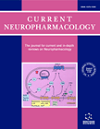- Home
- A-Z Publications
- Current Neuropharmacology
- Previous Issues
- Volume 17, Issue 11, 2019
Current Neuropharmacology - Volume 17, Issue 11, 2019
Volume 17, Issue 11, 2019
-
-
Why Should Psychiatrists and Neuroscientists Worry about Paraoxonase 1?
More LessBackground: Nitro-oxidative stress (NOS) has been implicated in the pathophysiology of psychiatric disorders. The activity of the polymorphic antioxidant enzyme paraoxonase 1 (PON1) is altered in diseases where NOS is involved. PON1 activity may be estimated using different substrates some of which are influenced by PON1 polymorphisms. Objectives: 1) to review the association between PON1 activities and psychiatric Read More
-
-
-
Partners in Crime: NGF and BDNF in Visceral Dysfunction
More LessAuthors: Ana Coelho, Raquel Oliveira, Tiago Antunes-Lopes and Célia D. CruzNeurotrophins (NTs), particularly Nerve Growth Factor (NGF) and Brain-Derived Neurotrophic Factor (BDNF), have attracted increasing attention in the context of visceral function for some years. Here, we examined the current literature and presented a thorough review of the subject. After initial studies linking of NGF to cystitis, it is now well-established that this neurotrophin (NT) is a key modulator of bladder pathologies, inc Read More
-
-
-
Cocaine-induced Changes in the Expression of NMDA Receptor Subunits
More LessAuthors: Irena Smaga, Marek Sanak and Małgorzata FilipCocaine use disorder is manifested by repeated cycles of drug seeking and drug taking. Cocaine exposure causes synaptic transmission in the brain to exhibit persistent changes, which are poorly understood, while the pharmacotherapy of this disease has not been determined. Multiple potential mechanisms have been indicated to be involved in the etiology of cocaine use disorder. The glutamatergic system, especially N-methyl- Read More
-
-
-
Highlighting the Role of Cognitive and Brain Reserve in the Substance use Disorder Field
More LessBackground: Cognitive reserve (CR) refers to the ability of an individual to cope with brain pathology remaining free of cognitive symptoms. This protective factor has been related to compensatory and more efficient brain mechanisms involved in resisting brain damage. For its part, Brain reserve (BR) refers to individual differences in the structural properties of the brain which could also make us more resilient to suffer fro Read More
-
-
-
Synaptic Elimination in Neurological Disorders
More LessSynapses are well known as the main structures responsible for transmitting information through the release and recognition of neurotransmitters by pre- and post-synaptic neurons. These structures are widely formed and eliminated throughout the whole lifespan via processes termed synaptogenesis and synaptic pruning, respectively. Whilst the first process is needed for ensuring proper connectivity between brain regi Read More
-
Volumes & issues
-
Volume 23 (2025)
-
Volume 22 (2024)
-
Volume 21 (2023)
-
Volume 20 (2022)
-
Volume 19 (2021)
-
Volume 18 (2020)
-
Volume 17 (2019)
-
Volume 16 (2018)
-
Volume 15 (2017)
-
Volume 14 (2016)
-
Volume 13 (2015)
-
Volume 12 (2014)
-
Volume 11 (2013)
-
Volume 10 (2012)
-
Volume 9 (2011)
-
Volume 8 (2010)
-
Volume 7 (2009)
-
Volume 6 (2008)
-
Volume 5 (2007)
-
Volume 4 (2006)
-
Volume 3 (2005)
-
Volume 2 (2004)
-
Volume 1 (2003)
Most Read This Month
Article
content/journals/cn
Journal
10
5
false
en


